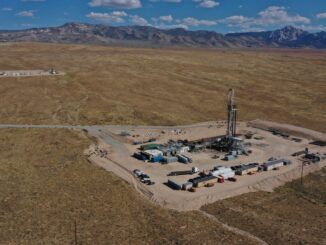
Fervo Energy is getting a lot better at drilling holes. According to data presented this week at Stanford University, it took the company 71 days to drill a geothermal well back in 2022. But last year in Utah, Fervo was able to get drilling down to 21 days, despite those wells being over 2,000 feet deeper. That has reduced drilling time by 70%.
Fervo is a buzzy, well-funded, and well-connected startup out of Houston that drills wells to produce enhanced geothermal energy, a clean source of power derived from heat beneath the Earth’s surface. But whereas traditional geothermal means tapping into hot water or steam underground, Fervo drills as deep as 9,000 feet down to access hot rocks, which are far more ubiquitous, and then pumps water into them, potentially unlocking many more areas for this kind of power generation.
This week’s announcement follows a pilot project last year where the company was actually able to produce electricity. Now the challenge is producing that electricity at scale — and that requires drilling faster.
Already its new timeline is translating in dramatic cost reductions, the company says, from $9.4 million to $4.8 million per well. For its Utah site, where it might need to drill 29 wells, back-of-the-envelope math suggests that could translate into up to $130 million in savings.
“The biggest expense in drilling is time it takes to drill. The easiest way to reduce drilling costs is to drill faster,” Fervo’s co-founder and chief executive Tim Latimer told me.
Latimer’s big idea behind Fervo is not just a conceptual one about how to generate geothermal power in areas that don’t produce steam or very hot water on their own, but also about how to apply the steady improvement and cost reductions seen in the oil and gas industry to non-carbon emitting power generation that can be available 24 hours a day.
“Oil and gas drilling has become incredibly much more efficient. That’s what drove the shale revolution. We were excited about 45-day wells and now you’ll see fields where people drill wells in 10 days or less,” Latimer told me.
Some of the improvement Fervo has achieved is due to porting over specific pieces of technology from the shale industry, like polycrystalline diamond compact drillbits and using them on the harder granite that Fervo drills. “Taking something that unlocked the shale revolution and making it work for hard rock was our whole thesis,” Latimer said. And there’s just been the steady improvements that come through experience and automation. Latimer described how they figured out a standardized, automated way to pick up and set down the drill bit so that the bit isn’t damaged when drilling starts up again.
“When we think about Fervo, a lot of the things we think about is not [how to] narrowly cut costs for one well, but ‘how do we create a system where you simplify well design and make its more standardized.’”
The idea is that there can be a “learning curve” with drilling geothermal wells, dropping costs over time. “We think geothermal will be on the end of that spectrum like solar or LEDs or battery that benefits from a learning curve because we figured out a way to standardize,” Latimer said. “Fervo is a learning curve company.”
These learning curves haven’t just been seen in fracking, but famously in green energy as well, especially standardized technology like solar panels, whose costs reductions consistently outpace expert forecasts. On the flip side, other forms of emission-free power, namely nuclear power, seem to be getting more expensive over time.
Fervo has also been capturing attention — and dollars — across the green energy community because of a specific type of power that enhanced geothermal could provide: 24 hour generation.
Other forms of non-carbon-emitting energy, particularly solar and wind, only generate power either at specific times or day (when it’s sunny) or when the weather is a certain way (windy). With enough transmission and batteries, these types of intermittent generation could power substantially more of the grid than they do today, but they can’t do it all — at least while keeping costs under control.
The need for 24/7 clean power has only been amplified by the Treasury Department’s proposed rules on green hydrogen, which would make hydrogen producers prove they’re using non-carbon-emitting energy for their operations in order to qualify for subsidies.
Latimer said Fervo’s inbox “blew up” after the proposed rules went out. “We’re every hydrogen tech’s favorite supplier now,” he said. But he noted that Fervo’s appeal was by no means limited to green hydrogen.
“Round-the-clock reliable electricity that doesn’t come with carbon emissions is not a hard sell, it just has to be a cost structure that makes sense.”
Fervo’s work is especially attractive to technology companies, who have long been pioneers in procuring green energy and are now interested in being able to get it 24/7. Fervo’s Nevada projects are contracted to provide power to Google’s data centers and other infrastructure throughout the state.
While Latimer would not say what Fervo’s current costs are, he did say that for it to be competitive, it would have to get down to around $100 per megawatt-hour, about where traditional geothermal — where steam or very hot water that’s already present underground is brought to the surface — is now. The Department of Energy’s goal is to reduce enhanced geothermal costs by around 90 percent to $45 per megawatt hour by 2025. “The results show we’re on the path to already being able to provide economic projects even at that market rate,” Latimer said.
And Fervo is continuing to get attention — and dollars — from the federal government. The Department of Energy announced Tuesday that Fervo was one of three companies — the other two being Chevron and Mazama — that would receive grants for their geothermal work.


